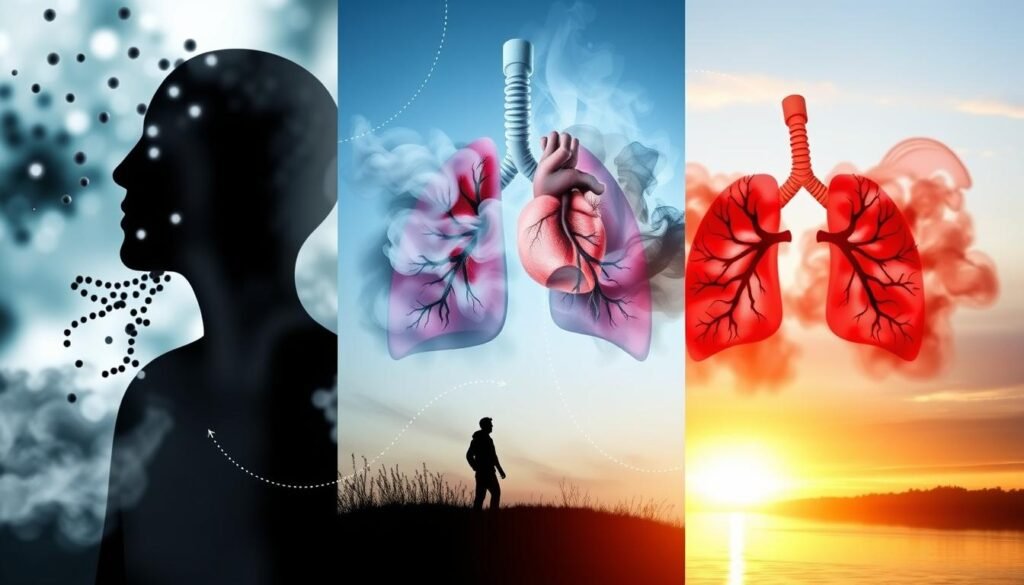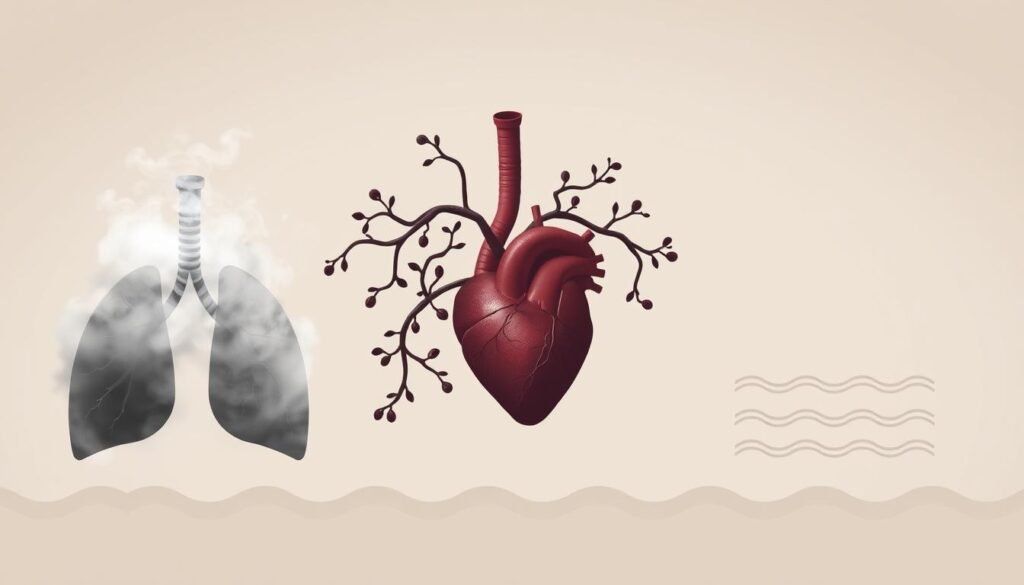Did you know about 1 in 10 adults in the U.S. have trouble breathing at some time? This fact shows how common breathing problems are. It also shows why it’s key to know the causes of difficulty breathing and fatigue. These issues can stem from respiratory conditions and lung diseases. They greatly affect one’s day-to-day life and general health.
Also, heart problems might make these conditions worse, leading to more fatigue and ongoing dyspnea. Understanding the possible reasons for breathing troubles can help people look after their health better. They can find the right medical advice sooner. This health guide helps connect the dots from causes to symptoms. It aims for a full understanding to help in quick action and smart care.
Key Takeaways
- Shortness of breath can stem from acute and chronic conditions.
- Common respiratory issues include asthma, COPD, and pneumonia.
- Heart problems like cardiomyopathy can lead to breathing difficulties.
- Fatigue often accompanies breathing issues and may indicate serious health concerns.
- Consulting healthcare professionals is crucial for accurate diagnosis and treatment plans.
- Preventive measures can help reduce the risk of developing breathing difficulties.
- Emergency attention is necessary for severe symptoms such as chest pain and wheezing.
Understanding Difficulty Breathing
Difficulty breathing is also known as dyspnea. It feels like you can’t get enough air into your lungs. This problem can happen while you’re active, resting, or feeling stressed. It’s important to know the symptoms because they could point to different health issues.
Asthma attacks are a common cause of dyspnea. They make it hard to breathe in and out smoothly. Pneumonia, a lung infection, leads to shortness of breath and a bad cough. Chronic obstructive pulmonary disease (COPD) might get worse over time, causing breathlessness suddenly.
Shortness of breath might be the only sign of a heart attack sometimes. This is a serious situation that needs quick help. Heart failure can also affect your breathing. It happens when your heart can’t pump blood well, causing fluid to build up in your lungs.
Heart rhythm problems, like atrial fibrillation, can make breathing hard. Many health issues can show up as shortness of breath. Being very overweight, not fit, or not managing asthma or heart problems well can make dyspnea last a long time.
People with breathing difficulties might breathe fast, wheeze, or have blue fingers or lips. These signs mean you should see a doctor quickly. If you’re worried about how you breathe or if it keeps happening, get checked by a doctor. They can help figure out why it’s happening.
For more details on what might cause this and how to deal with it, check the NHS guidelines about shortness of breath.
Common Respiratory Conditions
Many people’s lives are affected by respiratory problems. In 2017, a huge number, 544.9 million, suffered from chronic diseases of the respiratory system. COPD is a big problem worldwide. It caused the death of 3.5 million people in 2021. This illness includes emphysema and chronic bronchitis. They block the flow of air and make it hard for people to breathe.
Asthma impacted 262 million folks in 2019. It’s also widespread. Common signs are wheezing, feeling tight in the chest, and really short of breath. Asthma flares up when exposed to smoke, pollution, or allergens. This can make things much worse for people with asthma.
Pneumonia is another serious lung condition. It’s especially dangerous for the old and those with weak immune systems. This infection causes inflammation of the lung’s air sacs. This makes exchanging gas and breathing difficult. Catching and treating pneumonia early is key to avoiding bad health outcomes.
It’s important to know about these respiratory issues. This helps in handling and preventing them better. Good treatment plans include changing your lifestyle and sticking to your meds. Doing this can really help improve respiratory health.
Impact of Lung Diseases on Breathing
Lung diseases can really affect how we breathe. They lead to symptoms that change our daily lives. It’s crucial to understand these effects to manage diseases like COPD, asthma, and pneumonia.
Chronic Obstructive Pulmonary Disease (COPD)
COPD is a group of lung diseases that block airflow. This usually comes from long-term exposure to harmful gases or particles, especially from smoking. People with COPD often have a lasting cough, find it hard to breathe, and produce more mucus.
Statistics show that about 70% of COPD patients get out of breath with simple activities, like going up stairs. COPD does not only harm the lungs. It can affect the whole body and reduce the quality of life.
Asthma and Its Triggers
Asthma causes inflammation and narrowing of the airways, making it hard to breathe. Triggers can be allergens like pollen, dust mites, and pet dander, or irritants like smoke. Asthma can suddenly get worse, greatly affecting daily life.
Learning how to manage asthma triggers is key. It helps in avoiding severe asthma attacks.
Pneumonia and Pulmonary Infections
Pneumonia is a serious infection that makes the air sacs in the lungs inflame. They can fill with fluid or pus. Signs include coughing, fever, chills, and trouble breathing.
These infections can weaken the respiratory system. This makes it easier to get more complications, like respiratory failure. Knowing about pneumonia can lead to better treatment and less time in the hospital.
To learn more about chronic lung conditions, visit this resource. Knowing more about these lung diseases helps in getting an earlier diagnosis and better management, leading to a healthier life.
Causes of Difficulty Breathing and Fatigue
Our bodies may feel short of breath and tired for many reasons. It’s key to know why this happens to manage it properly. Shortness of breath that comes on quickly could mean an emergency, like heart attacks or infections. If it builds up over time, it might be due to ongoing health problems.
Acute and Chronic Shortness of Breath
Sudden shortness of breath can be scary. These symptoms might need quick help from a doctor. Things like a blocked artery to the lungs or a bad asthma attack are emergencies. Knowing these signs, like chest pain or extreme tiredness, is critical.
Chronic shortness of breath grows slowly from ongoing health issues. Diseases like Chronic Obstructive Pulmonary Disease (COPD), asthma, or low blood iron lead to breathing problems and tiredness. People with long-lasting shortness of breath feel tired as their body works hard to get enough oxygen.
Many things can make shortness of breath worse, whether it’s sudden or long-term. Common triggers include:
- Allergens like pollen and mold.
- Emotional stress or anxiety that leads to fast breathing.
- Hard physical activity, especially if you already have lung problems.
- Things in the air that bother you, like smoke or cold air.
Getting help early can make a big difference in feeling better. It’s important to understand how shortness of breath and feeling tired link together. They can point to bigger health issues that a doctor needs to check out. A complete check-up can find the reason and lead to the right treatment, easing symptoms well.

| Condition | Acute Symptoms | Chronic Symptoms |
|---|---|---|
| Asthma | Wheezing, tight chest | Frequent coughing, shortness of breath |
| COPD | Sudden worsened breath | Chronic cough, fatigue |
| Anemia | Weakness, dizziness | Fatigue, pale skin |
| Heart Issues | Chest pain, rapid heartbeat | Fatigue, shortness of breath |
Heart Problems and Their Effects
Heart problems play a huge role in many health issues, linking closely to breathlessness and tiredness. It’s key that our heart pumps blood right to stay healthy. If not, people can feel various symptoms, making daily life tough.
Common Heart Conditions Associated with Breathing Difficulty
Some heart conditions cause trouble breathing. The most seen is left-sided heart failure. Here, the left ventricle doesn’t pump well. This brings on shortness of breath, a fast heartbeat, feeling tired, and swelling.
Right-sided heart failure involves the right ventricle. It makes the chest hurt, ups urination, and swells ankles and legs. These signs need quick doctor visits. Babies can have congenital heart defects, leading to coughs, wheezing, and fainting.
The Link Between Heart Failure and Fatigue
Fatigue is common with heart failure, showing up as breathlessness, confusion, and less ability to exercise. Bad heart failure may cause kidney issues and high blood pressure in the lungs. Seek help right away if you see sudden weight gain, very bad breathlessness, or an irregular heartbeat. Here’s how these issues connect to certain symptoms:
| Heart Condition | Common Symptoms | Breathing Difficulty | Fatigue |
|---|---|---|---|
| Left-Sided Heart Failure | Shortness of breath, rapid heartbeat, swelling | Frequent, especially during exertion | Common, often worsening with activity |
| Right-Sided Heart Failure | Chest discomfort, swollen legs, frequent urination | Occurs due to pulmonary edema | Significant, associated with fluid retention |
| Cardiomyopathy | Breathlessness, fatigue, irregular heartbeat | Prevalent during physical activity or at rest | Notable, affected by heart muscle efficiency |
Other Health Conditions Contributing to Dyspnea
Dyspnea, or the struggle to breathe, can come from many health issues. Factors like anemia and obesity greatly affect breathing problems. Knowing how these conditions affect dyspnea helps manage health better.
The Role of Anemia in Fatigue
Anemia makes the body low on red blood cells. This lowers oxygen to tissues, causing tiredness and making dyspnea worse. With less oxygen, even simple activities or resting can make you short of breath.
Treating anemia may include changing your diet, taking iron, or getting transfusions. For more on how anemia affects breathing, click here.
Effects of Obesity on Breathing
Obesity has a big impact on how well you breathe. Extra weight reduces lung space, making breathing hard. This can make any breathing issues worse, increasing the chance of dyspnea.
Fighting obesity involves eating better and exercising more. Losing weight can really help with breathing and health overall.

| Health Condition | Impact on Breathing | Treatment Methods |
|---|---|---|
| Anemia | Decreased oxygen transport leads to fatigue and dyspnea | Dietary changes, iron supplements, blood transfusions |
| Obesity | Reduced lung capacity and increased breathing difficulty | Weight loss through diet and exercise |
The Role of Deconditioning in Breathing Difficulty
Deconditioning is key in causing breathing problems, especially for those with health issues. If you don’t move much, your breathing muscles get weaker. This leads to less lung power. People who are overweight or have conditions like asthma see this a lot. Studies show these individuals have lower peak oxygen levels, meaning they’re not as fit. This makes breathing hard when they’re active.
People with less conditioning get out of breath easily, even with light activities. This can happen because of physical limits or breathing the wrong way. Conditions like disordered breathing patterns are common reasons for feeling breathless. Treating these problems means focusing on physical activities and rehab that boost fitness and lung health.
For athletes or anyone with breathing conditions, exercise can trigger asthma or bronchoconstriction. Using inhaled steroids and beta-agonists helps manage these symptoms. It shows how vital staying fit is to prevent breathing issues. Even fit teens and adults can struggle with breathlessness if they’re not active enough.
Sleep Disorders That Cause Fatigue
Sleep disorders are a big reason why people feel tired all the time. One top cause is obstructive sleep apnea. This problem makes it hard to breathe properly when you sleep, leading to lots of tiredness during the day. It’s important to know how this affects our daily life.
Impact of Obstructive Sleep Apnea
Obstructive sleep apnea (OSA) really messes with how well you sleep. People with it might stop breathing up to 30 times every hour. Men are more likely to have it than women. But, women who are overweight or have gone through menopause are also at risk. This condition doesn’t just make you tired. It can also cause heart problems and mood changes.
Connection Between Sleep Quality and Daytime Fatigue
If your sleep is bad, you’ll likely feel tired all day. Conditions like OSA break up your sleep, making good rest hard to get. People need 7-8 hours of sleep for their best health. But those with sleep problems struggle to focus, do tasks, or stay happy. Plus, drinking coffee or alcohol can make sleep even worse.

| Risk Factor | Description |
|---|---|
| Obesity | Fat deposits can obstruct breathing in the upper airway, increasing chances of OSA. |
| Aged Population | Older adults show a higher incidence of both obstructive and central sleep apnea. |
| Smoking | Smokers are three times more likely to develop OSA compared to non-smokers. |
| Family History | Genetics can influence susceptibility to sleep apnea. Family history of the disorder heightens the risk. |
| Nasal Congestion | Chronic nasal congestion can contribute to obstructive sleep apnea risks. |
Emotional Factors Affecting Breathing
Emotional health plays a big role in how we feel physically. Stressful feelings can make it hard to breathe. It’s important to know about these emotional issues to handle them well. Anxiety and depression are two big emotions that can make us feel tired and stressed.
Anxiety and Panic Attacks
Anxiety can show itself through physical signs like not being able to breathe easily. Research links anxiety closely with trouble breathing. People with anxiety might have panic attacks, making it even harder to breathe. Practicing diaphragmatic breathing for 5 to 10 minutes every day can be a big help. Also, meditation and being mindful are good ways to lower anxiety.
- Cognitive Behavioral Therapy (CBT) changes negative thoughts to reduce anxiety effectively.
- Acceptance and Commitment Therapy (ACT) deals with deep emotions that cause anxiety.
- Medications like benzodiazepines offer quick relief but work best with therapy.
How Depression Contributes to Fatigue
Depression comes with its own issues, like feeling very tired. This emotional state can drain your physical and mental energy. This affects how you breathe. People with depression may not feel like doing much. Helping these emotional problems may reduce tiredness and breathing troubles.
| Emotion | Impact on Breathing | Management Strategies |
|---|---|---|
| Anxiety | Shortness of breath, panic attacks | CBT, mindfulness, diaphragmatic breathing |
| Depression | Increased fatigue, altered breathing patterns | Psychotherapy, antidepressants |
Emotions like these can start a cycle that affects both mental and physical health. Addressing emotional health can also improve breathing problems.
Conclusion
In summary, knowing why we feel tired and short of breath is vital for good health. Problems breathing can come from many places. This could be due to lung or heart issues, or even how we live our lives. We’ve shown how important it is to understand both fatigue and difficulty breathing. Together, they can greatly affect our life.
If you’re often struggling to breathe, it’s important to get help. Knowing whether it’s because of anemia, COPD, or exercise is crucial. For more info, check out resources on respiratory issues here.
Staying informed about our lung health helps us tackle symptoms early. Working with doctors, we can face these breathing challenges head-on. Realizing the signs of breathing problems and tiredness early can help us get better faster.